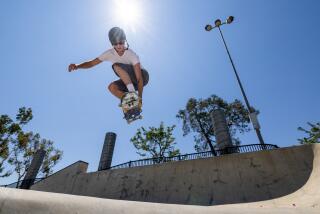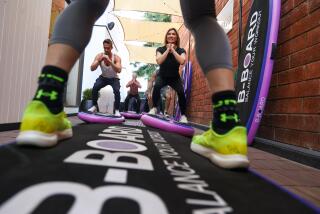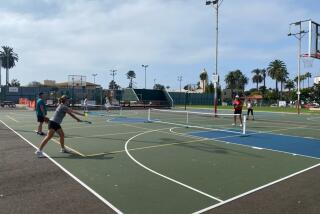Snakeboarding: It’s Sidewalk Surfing for Young and Restless
In your youth you were a righteous dude. As a gawky pre-teen you terrorized neighborhood streets on a skateboard--your parents terrified you would slam into a parked car, the neighbors terrified that car would be theirs.
Slightly older, you surfed your way around the globe, the highlight of your oceanic quest coming when, at a remote Indonesian reef break, you jumped out of a boat and nearly landed on the back of a shark. Young and reckless.
Unfortunately, these days you are neither.
Which explains, in part, why you are standing in a parking lot, rooted to the spot, arms swinging back and forth, trying to eke the remotest semblance of movement from the strange gadget beneath your feet. The gadget is shaped like a skateboard gone anorexic in the middle: two foot plates--each underlain with a pair of wheels--connected by a narrow bar about a foot long.
Wheels are designed to roll, but these wheels are spitting in the face of physics.
This fact is not lost on Brandon Eifrid. Eifrid is a snakeboard instructor, and he has kindly agreed to give you a lesson. Like any good instructor, Eifrid possesses two invaluable character traits--patience and a poker face.
“Don’t forget to move your feet,” he says, watching you swing your arms back and forth like a discus thrower mired in glue. “Put your toes together, then your heels together. Toes together, heels together. That’s what moves the board.”
For folks who don’t watch MTV, don’t own baggy pants and think “big air” is something that happens after eating too much chili, snakeboarding may require some explanation. Snakeboarding has actually been around for about four years, ever since a young South African surfer and skier named James Fischer, bored with conventional skateboarding, came up with a design that has two foot plates pivoting on either end of a stationary bar. By placing one foot on each footpad, then twisting his upper body and rapidly moving his toes in and out in a sort of pigeon-toed moonwalk, Fischer found he could mimic the motion of a surfer on a wave.
“It’s just like surfing on land,” Eifrid, a surfer, tells you. “You can really carve.”
In surfspeak, carving denotes radical, intentional changes in direction on the part of the rider. Adept snakeboarders can do this and more. Eifrid provides you with a videotape that proves this is so.
On the tape, snakeboarders, backed by driving rock music, hop benches and launch themselves off ramps, over barrels and down stairs, getting big air and then landing upright with a flashing display of braces. Eifrid swears that people over 20 snakeboard, though you don’t see many of them in the video. Top riders can attain pavement-warping speeds of 28 m.p.h. Eifrid himself has been clocked at 18 m.p.h.
At the moment, however, you aren’t going anywhere.
Along with patience and a stone face, Eifrid has a passing knowledge of neurology, too.
“The brain’s not used to doing two major things at once,” he says, watching your arms swing back and forth while your legs remain stone. “Maybe you should just concentrate on your feet.”
This is precisely what you are doing, but your legs, which can work a surfboard with some degree of proficiency, aren’t cooperating. In refusing to budge, they may actually be a step ahead of your brain, having already made the distinction between water and concrete. Besides, your brain, at the moment, is chewing over a particularly ugly skateboarding accident from years ago in which you jumped from the skateboard at 20 m.p.h. and took steps the size of Kansas before landing on your face.
You pose the question that’s uppermost in your mind.
“Can I get hurt doing this?”
Eifrid pooh-poohs the notion.
“I’ve never had an accident on the thing, not a single scrape,” he says, snaking about the parking lot to prove so.
The motion is fluid and graceful, a sidewinder whipping its way quickly across the road. What Eifrid doesn’t point out, and what you both know, is you’re not Eifrid. Which is why you remain as rooted to the firmament as a sidewinder that didn’t quite make the asphalt dash.
Like any good teacher, Eifrid focuses on the positive.
“You’re twisting your upper body really good. Move your feet a little more and you’ll be moving. Heels in. Toes out.”
You shuffle your feet. The snakeboard budges slightly, then, just as suddenly, comes to a halt. Eifrid is excited, perhaps sensing he’ll now be home before nightfall. When you met Eifrid at 9 this morning, he told you that most beginners achieve crude movement in about 10 minutes. Now Eifrid is only minutes away from missing lunch.
“That was it right there,” he says. “Did you feel the board move?”
Only the most sensitive seismic device could have detected movement, but you lie anyway.
“Yeah, that felt great. I really think I’m starting to get the hang of it,” you say. Eifrid nods, equally enthusiastic about engaging in this lie. “Now that you’ve got the movement down, it’s only a matter of time,” he says. “Just relax and let it flow.”
This would be easier had a busload of school kids not just pulled into the parking lot. They are all between 10 and 14, snakeboarding’s target audience, and before the bus squeaks to a halt, they are up in their seats, faces against the glass. Eifrid snakes about, and an excited buzz travels along the windows.
They watch you execute your cautious palsy with the thick silence kids reserve for hopeless dolts. You wish the driver would tell the little hoodlums to get back in their seats. “There, that was nice and smooth right there,” says Eifrid, interrupting your thoughts. “No doubt about it, you’re doing it.”
Indeed you can now travel a discernible distance. The motion is hardly fluid--more like the final spasms of some great, dying beast--and inevitably it ends in a jolting stop. But the particulars aren’t important. Progress is progress, and you are making it.
Eifrid and the buzzing school bus fade away. Your world becomes a narrow strip of concrete, and the feel of the snakeboard moving tentatively under your feet. Something familiar is happening here. Eventually you realize what it is. You are having fun.
Eifrid is smiling.
“Once you get the basics down, you’ve just got to keep doing it,” he says. “It’s like an addiction. And the longer you do it, the better you get.”
Truer words were never spoken.
More to Read
Go beyond the scoreboard
Get the latest on L.A.'s teams in the daily Sports Report newsletter.
You may occasionally receive promotional content from the Los Angeles Times.










